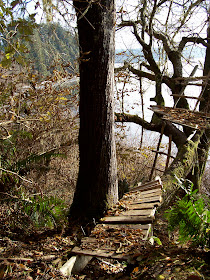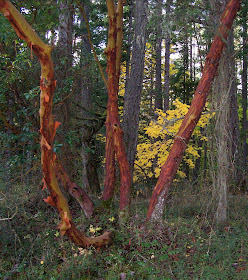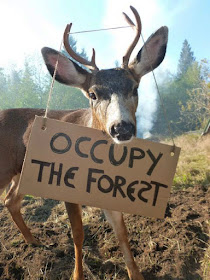 |
| This coastal Douglas-fir achieved old growth status 500 years ago. |
Many will agree that the old growth forests of Vancouver Island, and the world, are vital landscapes that need to be protected. However, there may be some disagreement over what compromises late-successional, or old growth forests.
The whole concept of old growth, and old growth management was born not far from here in the 1970s. A grass-roots movement was forming in the Pacific Northwest of the U.S. due to the continued loss of original forests, and fears of a diminishing biodiversity. Organizers were seeking a clear definition of old growth in order to be able to save it.
There are a few key factors and commonalities that can be used to identify old growth. More difficult may be convincing the powers that be that these forests are worth saving.
The following information is adapted from the Royal BC Museum
Living Landscapes web site:
Old growth forests are a major issue for the forestry industry throughout Canada and particularly in British Columbia. These forests are the source of potential economic wealth, but destroying them could have a greater impact than losing a few old trees.
There has not been one exact definition for old growth forests, as they can differ depending on climate, site characteristics, forest type and history of disturbances. On Vancouver Island it takes approximately 250 years for the forest to take on the structure seen in old growth settings. A stand of Douglas-fir can grow undisturbed for centuries.
Characteristics of Old Growth Forests
- Very Large Trees. This is highly dependent on climate, site characteristics etc., so is not a sole way of evaluating old growth forests.
- Very Old Trees. This factor also depends on many factors especially the area in which trees grow. The temperate rainforests of the coast commonly reach ages exceeding 250 years, which is generally when a forest begins to take on old growth characteristics.
- Complex Ecosystem Structure. A multilayered canopy is one characteristic that is said to be true of old growth forests.
- High Species Diversity. Many old-growth forests are have great species diversity, more so than a newer or second growth forest.
- Deep Litter Layer/LDWD. Old growth forests generally have a lot of accumulation of dead organic matter on the forest floor when they have remained undisturbed by fire for centuries. One component in the structure of the litter layer is the presence of large diameter woody debris (LDWD), or large, downed trees. These trees may take many decades to decay, provide rich habitat, and return nutrients to the soil.
In British Columbia, there have been ongoing calls to protect the remaining old growth forests, particularly the coastal temperate rainforests that occur on Vancouver Island. Each year almost 200,000 hectares of old growth forest are clear cut.
Concerned citizens have staged some of the largest mass civil disobedience movements in Canadian history in order to protect increasingly threatened public forest lands. These actions have impelled provincial governments to take their responsibilities to protect the public interest seriously.
There have been changes, although it remains to be seen how far the government is willing to go in ending old growth logging completely. The BC government established an Old Growth Strategy in 1992, and has been increasing the number of Old Growth Management Areas (OGMA) that seek to protect more old growth forests and their ecological and cultural assets.
Progress has been made since the 1970s, and after a major campaign, the government divided the Carmanah Valley in half. Rather than clear cut the entire valley, the bottom was set aside for a park in 1990, while allowing the upper areas to be logged (which may have impacts on the bottom part of the valley). Had the original logging request been allowed, the tallest Sitka spruce trees in Canada would have been destroyed.
Clayoquot Sound on Vancouver Island, has been a focal point since the 1980s, in BC and globally, over forest value and issues of environmental and economic sustainability. In 1984, the first logging blockades in Canadian History occurred on Meares Island, resulting in the protection of its ancient forests.
Clayoquot represents 262,000 hectares of which 244,000 are forested. Over 30,000 hectares have been logged to date, and only 39,100 hectares are in protected areas, and the remaining 90,400 hectares of commercially productive land is mainly old growth forests.
We know, roughly, what an old growth forest is. We know that they are vitally important in providing crucial environmental services such as water purification, soil retention, and carbon storage. And we know that given current policies all original old growth forests will be degraded, depleted, and destroyed over the next few decades.
It is time to stop harvesting old growth forests in BC, and around the world.
















































